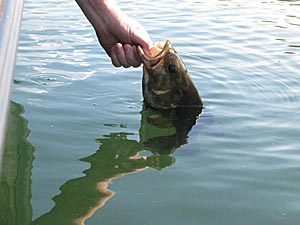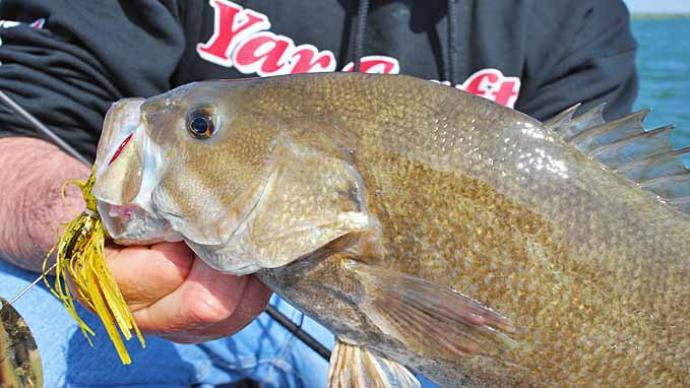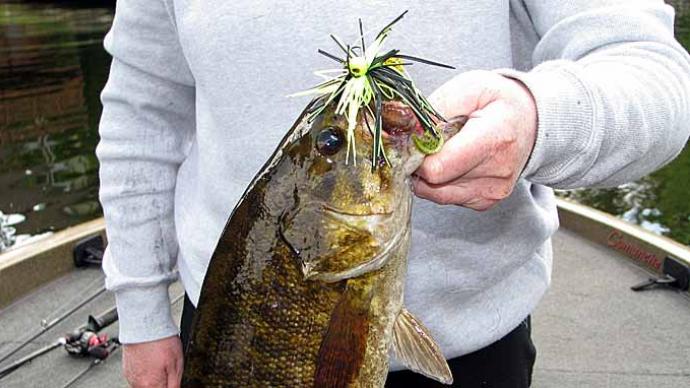
Living in Ontario, Canada on the north shore of Lake Erie, has taught me to be versatile. I have not only learned to target largemouth bass in areas you wouldn't expect to find them, but I have also learned to fish smallmouth bass as a primary target fish in tournaments and to fish other species with general expertise. While I still have a lot to learn, I have learned enough about smallmouth to put together a pretty good pattern regularly, not just on Lake Erie but on any lake with a decent population of bronzebacks. Hopefully, with this, I can help you to cash in on perhaps the feistiest of the bass species - the smallmouth bass.
Smallmouth, in general, are a tough fish to pattern. Many pros say you can't do it seasonally, as they are unpredictable roaming fish. And they are. They are heartbreakers to most in tournament situations as they tend to be "there one day, gone the next" type of fish. The name of the game is finding more than one productive smallmouth hole and fishing them one at a time. But what is a productive smallmouth fishing spot? How do you know how deep to fish? Are they picky about colors and bait sizes?
A productive smallmouth spot will generally be slightly deeper water than the largemouth likes to hide in, or at least have quick access to deeper water nearby. Smallmouth usually travel in schools and follow the baitfish or potential baitfish holding areas. Anyone who fishes a river knows to look for current breaks near a deep hole, bend, or channel in the river. These are smallmouth hotspots. Well, these are hotspots in most lakes, too.
For instance, while fishing for largemouth many years ago, my father was drifting over weedbeds in 7 feet of water, casting spinnerbaits and fat crankbaits. His partner saw a particularly deep section in the weeds, cast to it, and caught a hefty 5-pound smallmouth bass. My dad quickly threw a marker buoy to that spot and kept the boat in a position so they could both continue casting at the spot. Sure enough on my dad's next cast with a white spinnerbait, he got a 4-pound smallmouth. After they were sure they had "fished out" this hole, probably 2 hours later - they moved up to it to look. It turned out that this was a meteor crater, which left an indent about 15x15 feet wide and 12 feet deep! This small depression held smallmouth in a flat area known for largemouth and pike fishing. This shows you that deep water access is necessary for big smallmouth bass.
Alright, you say, just go to deep areas and start fishing! Well, no, it's not that simple. While largemouth are primarily cover-oriented and will seek areas on structure with heavy weeds, docks, or timber - smallmouth tend to find structure of more importance. This means areas like humps, points, and channels. Find deeper humps, points, or channels with some rock or weed cover on them - and you have a recipe for success.
The point you want to look for is preferably a rocky or sandy point stretching from shallow to deep water. Usually, points, especially in river basins, will have one side that drops off much steeper. Smallmouth will often position themselves on the deeper edge of these points and ambush anything that ventures over top of them. I can't tell you how often I have seen smallmouth chasing shiners or dragonflies near points like this early in the morning. With a cottage that I often visit on a Canadian Shield lake, I know a lot about the ambush habits of smallmouth on rocky points.
I like to fish these points by positioning my boat 20- to 50 feet back from the deep edge of the point. I will cast my baits onto the shallow side and run them back over the deep water, as the bass are waiting for feeble baitfish to do this. My preferred baits for this are topwater baits like Jitterbugs, buzzbaits, or jerkbaits early in the morning and throughout the day on some days.
A spinnerbait, deep diving crank, tube jig, or jigging spoon usually do the trick as daylight wears on. Many anglers overlook the jigging spoon, but they shouldn't! I have caught countless big smallmouth in areas on jigging spoons where others are using tube jigs or crankbaits. The trick is to cast the jigging spoon as close to the edge of the drop as you can and let it sink, then jig it in and reel up the slack until you get back to the boat. Try to keep the bait at the depth where the fish are sitting. If you don't know their position, try different depths until you get a fish.
The kinds of humps you want to look for are just about any hump in 8-25 feet of water or deeper in the case of early spring/late fall. Humps with any cover on them are worth giving some time. For most hump fishing, it means vertical jigging of some sort. While you can get fish on baits like spinnerbaits and crankbaits if you put your time in, my first go-to bait when fishing humps is a tube jig, Carolina-rigged plastic worm, or a jigging spoon. I use my depthfinder to find areas where bass are holding, or where baitfish are holding. Always remember to fish different areas within the hump. Sometimes smallmouth will group tightly on one corner or edge of the hump because it is more oxygenated or blocks current. When you find fish on these humps, you'll likely get a bunch! I've never fished a hump where the smallmouth weren't schooled up.
You must fish like a river when fishing channels on reservoirs or feeder creeks. Since most all channels have current, you will want to look for subtle current breaks or cover. Bends in the channel are prominent spots that most people will fish. I also like to fish areas where the channel is beside a shoal or flat. This is incredibly productive in the spring when smallmouth are starting to spawn. When the water reaches 50 degrees, the bass will seek out that shallower, flat spawning type bottom to nest on. Sometimes, areas of the channel will fill in, or sand bars will be on it. These are significant areas to key in on. Sandbars are a favorite for the smallmouth bass, and they will sit on the deeper side and await baitfish or other food to come down their way right into their mouth!
This is my favorite spot to fish the ever-so-popular tube jig. Many people drag it over the bar and let it drop into the deeper slack water behind it. This is a great tactic. But don't ever rule out anchoring and vertical jigging. This is also an excellent spot for a jigging spoon. And remember your crankbaits! Cast them up current and chunk them back. Active smallmouth usually ambush the crankbait as it comes flying over the sandbar.
Hopefully, with the tactics in this article, you can seek out smallmouth on new fishing waters and put some good ones in your livewell. I still have a lot to learn about smallmouth, but these are the tactics that I have picked up. Remember to have lots of areas to catch smallmouth because, on some days, they will be in a spot, but within days or even hours, they can roam off of that spot in search of new baitfish areas. They are efficient feeders and are much more active than their large-mouthed cousins. That may be why they're so muscular and put up such a great fight on lighter gear! Whatever the case, give smallmouth a fair shot the next time you fish new water, and put these tactics in your arsenal.
Good luck, stay safe, and tight lines! Until next time, this is Rich.




